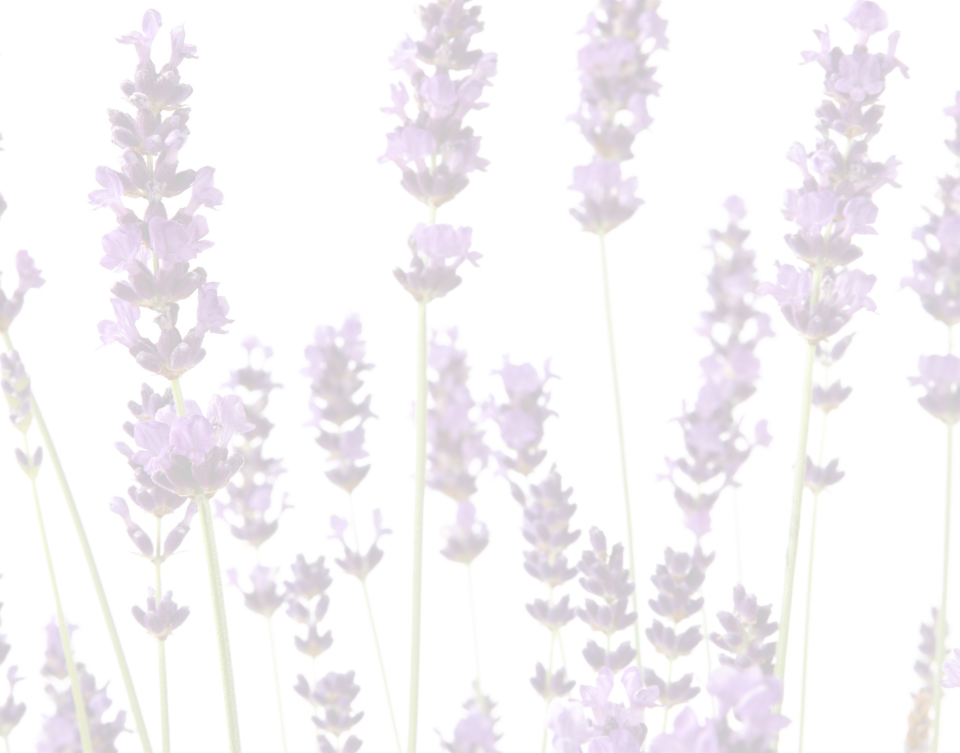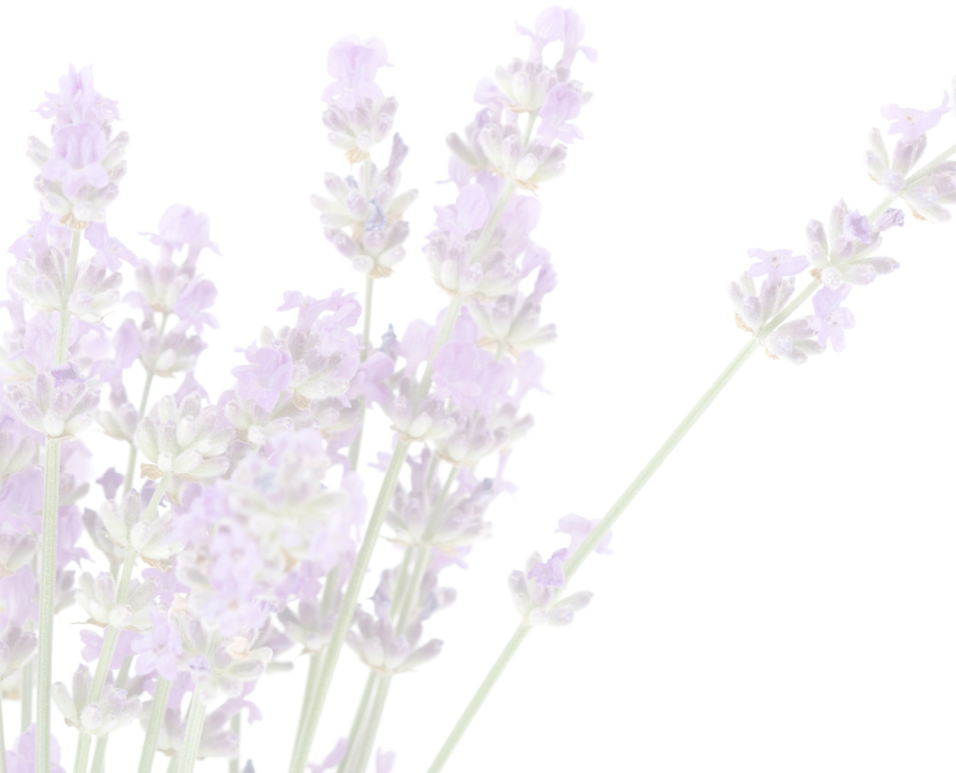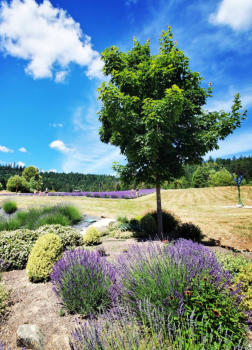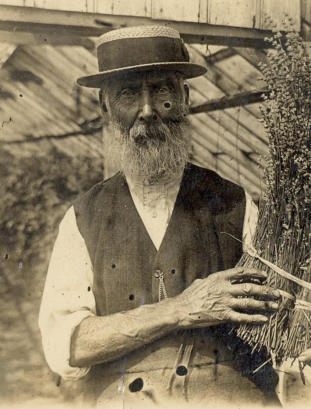

The history of lavender sometimes seems fluid with dates and events changing with the seasons and the telling. Here on the
farm we read what we can and share the stories that explain and entertain. If you are interested in more of the history of this
beloved and revered herb consider perusing the information available on Wikipedia by clicking the button on the right.



We're told that the Greeks and the Romans used lavender as a perfume; for bathing and in
laundry. In the Middle Ages its use has been linked to the fight against infectious diseases since
there was a belief that odors spread disease. Lavender was grown in the gardens of convents and
monasteries and may have been used for medicinal purposes especially after the outbreak of
plague in Provence in the South of France.
In the late 18th century an industry grew up around the town of Grasse for the production of
perfume in which lavender essential oil was a key ingredient. This gave work and income to some
of the poorest communities in southern France, especially as their land was unsuitable for other
crops, and there was an abundance of wild lavender after the peasants had abandoned their fields
during the industrialization of the first half of the century. Cultivating and picking lavender became
an important focus for the peasant farmers and their families.
Gradually farmers became more organized and equipped themselves with stills and were able to
extract the essential oil themselves. In the early twentieth century the demand for lavender
essential oil by the perfumeries grew considerably and farmers learned how to propagate and
transplant lavender to the hills surrounding many of the small villages in France. After the World
Wars the introduction of mechanical cutting techniques displaced many small farmers once again
and the lavender crops became concentrated in certain areas mostly around the town of Sault. At
the same time a synthetic product appeared on the market (lavender fragrance oil) and in large
part replaced the widespread use of natural lavender essential oil in cheaper consumer products.
In 1972 a grower named Pierre Grosso (1905-1989) discovered some unusual lavender plants in a deserted field in the Vaucluse district of France. He took
some cuttings which turned into healthy plants with multiple flower spikes and oil yields in excess of those from lavandula species. In 1975 the Grosso
variety was updated from the old form of "Abrialis" to the new Grosso lavandin which is now the preferred crop for farmers in the south of France for its
longevity and superior oil yields.
Lavender essential oil however has retained its place in the luxury perfume market and in the development of herbal medicine and aromatherapy
industries and is prized for its delicate aromas.
In England it is believed that lavender was introduced by Queen Eleanor of Provence in the 1300s and was probably grown for its uses as a component for
strewing over earthen floors to improve odors and repel vermin rather than as a plant in a garden. It is believed that lavender was brought to North
America by the English although they had limited success cultivating it. It was not until the early twentieth century that commercial lavender growing really
took hold in the Pacific North West due to the pioneering work of L.J. Wyckoff from Seattle. Lavender has seen something of a revival in recent years and
The English Lavender Farm joined five other lavender venues in 2014. Today there are fewer farms in and around the Applegate Valley and we hope that
will change with new venues preparing to open in the spring of 2019.
Lavender
Lavender Varieties Grown On The Farm
Augustifolias (English Lavender)
Folgate
Folgate is one of our favorites – it is a smallish plant – usually around 24” wide
with narrow, small leaves and a sweet aroma. The color is a beautiful light
purple and we use this variety for cut flowers and wreath making.
Hidcote
The darkest purple of all the lavender we grow is produced by our “Hidcote”.
This is a dense lavender plant which has a stronger aroma than some English
lavenders and is probably the most popular for landscaping. It is typically
smaller than average Angustifolias; ours are about 20” across. Hidcote makes
a great dwarf hedge or can be used for edging or for creating borders.
Sharon Roberts
Sharon Roberts is a very open, violet / blue plant that has long but sometimes
kinky stems growing to about 40” in diameter. It tends to splay out as the plant
ages but flowers for the longest time and is very fragrant. Again, this was
introduced in Oregon and named after the grower’s wife.
Buena Vista
Buena Vista makes for excellent dried bouquets so long as we cut the stems
before most of the flowers are fully open. We made the mistake of harvesting
them too late in July a couple of times and were very disappointed in the
difference that made to the dried bundles. This was also a lavender introduced
by an Oregon nursery and was named after the road that the owner was
situated on. We have had slightly more difficulty propagating Buena Vista than
other varieties. Buena Vista has a strong fragrance, distinctive and very dark
blue calyxes and lighter blue flowers and reaches about 40” across when fully
grown.
Royal Velvet
Royal Velvet is grown at the English Lavender Farm as a culinary herb
because of its sweet flavor. It is a soft violet color and is very fragrant. It was
introduced in Oregon in 1988 and grown from seed originally collected in
England. The full-grown plants reach about 40” wide is one of the most popular
lavenders currently.
Tuckers Early
Tuckers Early is a fragrant, leggy variety that sometimes blooms twice – the
last time being in Fall and reaches about 30” across. The bloom time is quite
long, being one of the earliest to flower and one of the last to finish. We use this
variety for dried bundles.
Melissa
Melissa is one of the more recent lavender varieties that we grow – it was
developed in 1999 in Oregon and named after the grower’s wife. It is an erect
tightly compact bush with white calyxes which reaches 36” in diameter. When
the flowers open, they are also white and then become pale pink. Melissa has
a slight peppery taste and is often used in culinary dishes where color is not
important.
Betty’s Blue
We grow Betty’s Blue because it is a compact erect plant with no splaying. The
flowering spikes are dense and a dark violet color which lend themselves well
to cut flowers and wreath making. This variety was introduced by an Oregon
nursery and named after their manager Betty Walker. Betty’s Blue reaches
about 24” wide.
X-Intermedias (Lavandin)
Grosso
We grow Grosso from softwood cuttings (not seed because the hybrids are
sterile) and they produce a very dark purple color and are very pungent. We
use the dried buds for sachets and heated lavender neck wraps. Our Grosso
plants are typically 5’ in diameter and flower after the Angustifolias in July.
Provence
Provence is another hybrid lavender that can reach 6’ across. They are a
lighter purple than “Grosso” and we tend to use the stems for making lavender
wands. Provence does not dry well in so far as the buds do not stay on the
stems but fall off very easily (which is great if you want to use the buds in
crafts).
Phenominal
Our Phenomenal is probably one of the hardiest of the hybrid lavenders and in
July produces elegant lavender colored calyxes and flowers on long stems that
wave in the summer wind. The plants reach about 4’ in diameter and the stems
are mostly used in fresh bouquets and in lavender wands. This variety is
protected by a patent and we are not allowed to take or sell cuttings.
The History of Lavender
For More Lavender History
We grow a number of varieties of lavender on the farm, almost all of them stem from "true" varieties grown
by Sarah Bader at Lavender at Stonegate in Oregon and any new plants have been propagated from the
original starts so we can be sure of their heritage. The majority of our plants are of the Lavandula group - in
the main they are Angustifolias or English Lavenders and we have a small number of X-Intermedia Lavandins
or hybrid plants.
Choosing lavender for your own garden may seem overwhelming given the array of types and varieties. It
might help to think of lavender as three groups. The lavender we grow are all Angustifolias usually referred to
as “English”. Compact plants generally growing to be 28” in width and height. We also have some X-
intermedias which are often referred to as “French”. These plants tend to be larger, up to 36” in height and
width in some cases. Lastly there are the Stoechas varieties which have much more dense heads with little
“bunny ears” emerging from the top. We prefer the first two types because their fragrance offers a traditional
lavender profile. The Stoechas lavenders are pretty in their own right but their perfume is somewhat lacking.
After deciding on the general area you are planting and how tall you would like the plants then visit farms or
gardens of family or friends to discover how each variety look and smell. Try not to get too technical because,
after all, its just there to smell and look good!
Before buying, consider that your new plantings will require full sun and will need frequent watering for its first summer. After the plant is established
you can cut back on watering. And speaking of watering… lavender does not tolerate having wet roots for long. In well drained soil lavender can be
watered often. In heavier soil watering should be curtailed to allow roots to dry out between waterings. In heavy clay, well, don’t plant lavender!
If all of this seems like too much information then please come by the farm or stop by and visit us at a local farmers market and we will be happy to share
what we know.

















